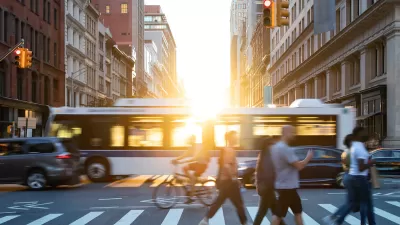Motor vehicle travel benefits users but also imposes large economic, social, and environmental costs. With better planning, our needs can be met with less vehicle travel. A new ITE report describes why and how to optimize the amount we drive.

Motor vehicle travel provides many benefits, but also imposes large economic, social and economic costs. A new Institute of Transportation Engineers report, Vehicle-Miles Traveled (VMT) as a Metric for Sustainability, can help guide planning to optimize the amount people drive.
This is an important and timely issue. Per capita vehicle-miles traveled (VMT) grew steadily during the Twentieth Century. During the growth period, transportation agencies applied “predict and provide” planning practices that contributed to a self-reinforcing cycle of expanded roads, more parking subsidies, reduced non-auto travel options, and sprawled development patterns that created automobile-dependent communities where it is difficult to get around without a car.
Per capita motor vehicle travel peaked about 2005, and current demographic and economic trends (aging population, rising vehicle costs, changing consumer preferences, increased health and environmental concerns) are increasing non-auto travel demands. In response, many transportation agencies are shifting from mobility-oriented planning, which assumed that our goal is to maximize travel speed and distance, to accessibility-oriented planning, which recognizes the ultimate goal of transportation is to provide access to services and activities, and policies intended to increase mobility often reduce accessibility in other ways.
To achieve sustainability goals, many jurisdictions are now reforming their planning practices to support accessibility-based planning. Some have established vehicle travel reduction targets to help guide these reforms. These policies can be justified for several reasons: to support more multimodal planning, to reduce traffic congestion, to reduce road and parking infrastructure costs, to reduce pollution emissions, and to improve community livability, public fitness and health.
This report discusses how much vehicle travel can be reduced, appropriate analysis methods and planning practices, and effective VMT reduction strategies. It also includes case studies from locations that optimized vehicle travel in the United States and internationally.
FULL STORY: VMT as a Metric for Sustainability

Planetizen Federal Action Tracker
A weekly monitor of how Trump’s orders and actions are impacting planners and planning in America.

Maui's Vacation Rental Debate Turns Ugly
Verbal attacks, misinformation campaigns and fistfights plague a high-stakes debate to convert thousands of vacation rentals into long-term housing.

Restaurant Patios Were a Pandemic Win — Why Were They so Hard to Keep?
Social distancing requirements and changes in travel patterns prompted cities to pilot new uses for street and sidewalk space. Then it got complicated.

In California Battle of Housing vs. Environment, Housing Just Won
A new state law significantly limits the power of CEQA, an environmental review law that served as a powerful tool for blocking new development.

Boulder Eliminates Parking Minimums Citywide
Officials estimate the cost of building a single underground parking space at up to $100,000.

Orange County, Florida Adopts Largest US “Sprawl Repair” Code
The ‘Orange Code’ seeks to rectify decades of sprawl-inducing, car-oriented development.
Urban Design for Planners 1: Software Tools
This six-course series explores essential urban design concepts using open source software and equips planners with the tools they need to participate fully in the urban design process.
Planning for Universal Design
Learn the tools for implementing Universal Design in planning regulations.
Heyer Gruel & Associates PA
JM Goldson LLC
Custer County Colorado
City of Camden Redevelopment Agency
City of Astoria
Transportation Research & Education Center (TREC) at Portland State University
Jefferson Parish Government
Camden Redevelopment Agency
City of Claremont





























